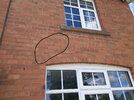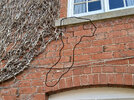Even before this latest, very dry summer my parent's house showed signs of cracks. It is originally a late 1800s property with an extension built on the side in the early '60s. When I was a youngster there until the early 80s, there was a separation crack between the old and the new. In fact at one point they had ivy growing through with odd leaves visible in one of the upstairs rooms.
With this latest dry spell, cracks have become visible in the main walls, below the windows of the 'extension'.
My question: is this subsidence? Or could it be called 'settlement cracks' or historic perhaps?
We're not concerned that the place may be falling down, it is more to do with declaring on the insurance.
With this latest dry spell, cracks have become visible in the main walls, below the windows of the 'extension'.
My question: is this subsidence? Or could it be called 'settlement cracks' or historic perhaps?
We're not concerned that the place may be falling down, it is more to do with declaring on the insurance.



